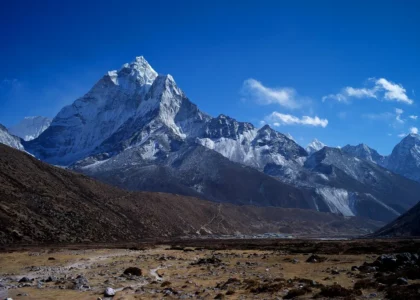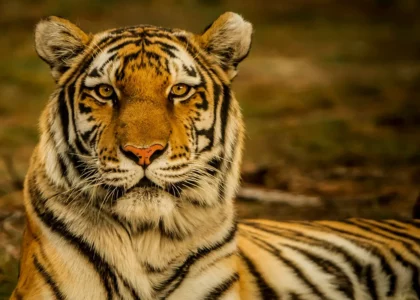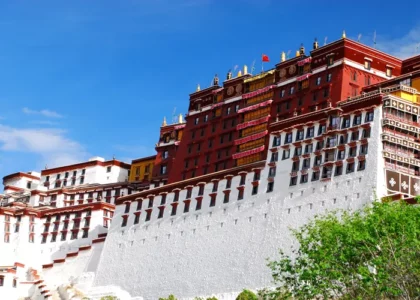Sagarmatha National Park, Tourism, Its History and site to visit

Sagarmatha National Park is the most beautiful in the middle of the Himalayas. This national park was established in 1976 in the Solu Khumbu district in northern Nepal. This region comprises the great Himalayan range from the international border with Tibet. Meanwhile, the southern part consists of the Dudh Koshi River.
Mountains surround Sagarmatha National Park from all sides. From this national park, you can get a spectacular view of the mountain peak over 8,000 m. You can also see various other small peaks and the great Mount Everest. Most of Sagarmatha National Park includes barren land. Research says that 69% of this national park is empty land, 28% is grazing land, and 3% is forest.
Sagarmatha National Park Tourism
Sagarmatha National Park is a well-known wildlife reserve in Nepal. This national park is famous among trekkers for its view of the high mountains of eastern Nepal and Mount Everest. Solu Khumbu district is a favorite tourist spot in Nepal; this place has been open for outsiders to trek since 1960.
The people are famous for their stunning scenery and the local lifestyle. The trail to Sagarmatha National Park is adventurous, as it involves going through coniferous forests. Hiking and walking in the Khumbu region are very famous among trekkers.
UNESCO has included Sagarmatha National Park as a World Heritage Site. It has been a preservation site for rare animals and birds for a long time.
The Red panda and Snow leopard are the rare animals in Sagarmatha National Park. Sagarmatha National Park is comprised of 1100 square kilometers. The birdlife of Sagarmatha National Park has been a significant tourist attraction. Visitors enjoy bird watching while enjoying the mountains.
History
Sagarmatha National Park is the first national park of Nepal that was included as a World Heritage Site by UNESCO. This national park was founded in 1976 and enlisted in UNESCO in 1979 BS. According to the buffer zone management guidelines, a Buffer Zone of 106 sq.mil was added to conserve forest, wildlife, and cultural energy. An alternative source of power was also developed for a very long time. Sagarmatha National Park is the protection center for the birds and animals in the Khumbu region.
According to the survey, about 19,000 tourists visit Sagarmatha National Park annually. Most Sherpa people live in that village.
Cultural and Heritage
The Sherpa and Gurung people live mainly in the Himalayan region of Nepal. Gurung and Sherpa people are unique in culture. Initially, people of Sherpa culture lived in the Salmo Gang in the eastern part of the Tibetan region. They left Tibet in the 1400s and 1500s to arrive in Nepal’s Himalayas. While entering Nepal, they separate themselves into two groups, Khumbu and Solu. People of the Solukhumbu region are used to the altitude of the area. Almost everyone in the Khumbu region follows Buddhism, meaning many small and significant monasteries are on the trail.
Locals have decorated the trail with the Buddhist flag. The flag is in script with the Buddhist prayer that addresses “OM Mani Padme HUM,” the famous Buddhist sentence that means, “Hail to the Jewel of the Lotus.” The mountains and trekking experience influence the local life of the people.
Thayangbche Monastery is the oldest monastery, built in 1989—Trekkers like to observe the people’s culture and traditions. Festivals like Tiji, Dashain, and Buddha Purnima are celebrated grandly in the Khumbu region. Moreover, the people of the Khumbu region believe in hospitality and a welcoming nature.
Sagarmatha National Park Entry Fee and Timings
Generally, Sagarmatha National Park is open 24 hours a day for everyone’s convenience. However, we suggest you do not visit the park after sunset, as it will be dark all around and is a bit risky, as there is a lot of wildlife there. Also, do not walk alone anywhere in the park.
First, you should buy the access pass to enter Sagarmatha National Park. You can buy the pass from the visitor center at Monzo and Namche Bazar. The cost of entering a pass depends on which country you belong to. If you belong to any SAARC country, you must pay RS 2400 per person, whereas foreigners must pay RS 4800 per person. It would help if you had your password to get the pass.
Safety
You should be aware of the safety precautions you must follow. Situated in a higher Himalayan range, trekkers trekking to Sagarmatha National Park can have altitude sickness. Although you will have a trekking guide, you should take the necessary precautions. For instance, you should not trek the elevation of 300 meters in a day.
It would help if you managed your itinerary accordingly. If you travel higher than 300 meters in a day, you will have to rest so your body gets time to relax. That is why it should take some days in between the treks.
It would help to be careful while visiting the national park, as the narrow route is.
It would help if you did not disturb or harm any animals or birds there. You should follow specific rules inside the park; you can read the rules on the board.
VISITOR FACILITIES
Visitors have been continuously increasing over the last couple of years. The summer and monsoon seasons are the most challenging, as the weather becomes freezing. Therefore, relatively fewer people visit Sagarmatha National Park during this season.
Sometimes, the crowd on the trail gets higher, but the entire trail will provide you with a spectacular view of the mountains. During the trek, you will go through Kala Pattar, the famous viewpoint for the thrilling view of Mt.Everest. The Sagarmatha National Park trek will take you to the world-famous Everest View Hotel and Syangboche. Namche Bazar is another well-known spot for tourists to observe the local life and culture of the people. There are different hotels and lodges which provide food and accommodation facilities.
Namche Bazar has an information center and interpretative service to ease the treks. At Sagarmatha National Park, they will provide you with the handbook with the required information about the park. For transportation, you can either take a roadway starting from Kathmandu or an airstrip from Kathmandu airport to Lukla.
What is the best time to visit Sagarmatha National Park?
Although Sagarmatha National Park is open throughout the year, the weather and conditions might be worse sometimes. Therefore, the perfect time to trek to Sagarmatha National Park is from mid-September to the end of November. As the weather is cold during this time, you can witness the animals and birds in their natural habitat.
You can see the snow leopard roaming around in actual snow if you are lucky enough. Another best time to visit Sagarmatha National Park is from March to May, which includes suitable weather conditions. Prescription during these months is very low, so there is no chance of delay. Trails typically remain crowded during the peak seasons. You can visit from April to June or March to April to avoid unnecessary crowds.
Local transport in Sagarmatha National Park
You can reach the Khumbu region by air or road. However, from Phakding, you will have to trek, so the only option to go on the Sagarmatha National Park trek is by foot. An alternative to this is to ask for a helicopter trek to Sagarmatha National Park.
A helicopter tour is quite expensive and can be completed within a day. However, if you plan to trek to Sagarmatha National Park, plan your itinerary and stick to it. It is better to stop your trek before sunset, as walking after sunset might be dangerous.
Moreover, it would help if you consistently carried travel lights, edibles, and water. You can hire a porter to carry your luggage, as there is no facility for public transportation. Locals employ Yaks to carry heavy loads. Continuously trekking might not be difficult for you to take a day off to acclimate.
Places to visit during Sagarmatha national park trek
- Everest base camp
This is a world-famous trekking destination. Everest base camp is the dream place for most adventure geeks. This trek will give you the experience of seeing the world’s highest mountain from Kala Patthar. From Kala Patthar, you can get a view of the entire northern face of Mount Everest. Sagarmatha National Park and Everest Base Camp are near each other. If you visit Sagarmatha National Park, you must see Everest Base Camp.
- Witnessing High Mountain
You can view other mountains like Mount Taboche, Ama Dablam, Lhotse, and other minor peaks along with Mount Everest. These mountains are the major attractions of Sagarmatha National Park. You can get a magnificent view of these mountains throughout the trek. This mountain adds beauty to the Sagarmatha National Park.
- Khumjung village
Khumjung village is an underrated village at an elevation of 4000 meters. It is near Mount Khumbila. Scott Fisher Memorial and School are located in this village. This village is the most beautiful place, with innocent and welcoming people. The local culture and mountains all around are the specialty of this village.
Gokyo Lake
You must visit this place during your visit to Sagarmatha National Park. Gokyo Lake is the world’s highest lake, containing six lakes. Mountains surround this lake, and you can get breathtaking views of the mountains, including Everest. Trekkers prefer to go to Gokyo Lake early in the morning to camp and spend the rest of the day.
- Monasteries
As most people in the Khumbu region are Buddhists, there are more than 50 monasteries throughout the trail. The main monasteries are Tengboche, Thame, Khumjung, and Pangboche. Tengboche monastery is the oldest monastery. People decorate the monastery during the Mane Rimdu and Dumie festivals.
Where to stay in the Khumbu region?
There are different places for accommodation within the national park. You can stay in a basic hotel, lodges, teahouse, or camping. There are hotels and teahouses on the trail to offer the food. Main hotels are at Phakding, Namche Bazaar, Thayangbche, Pheriche, and Lobuche.
According to the report, there are 380 lodges on the trail to the Khumbu area. There was no resort on the trek earlier, but several have been established. You may have to book the hotel early during peak seasons. You might not get proper rooms due to the high crowd. Dal Bhat and Tarkari are the most common foods in the Khumbu region. You can also get luxurious food at the resorts and lodges.
Village life in Khumbu region, Himalaya, Nepal?
The Khumbu area trek passes through various villages. This national park, which includes Mount Everest, covers an area of 124,400 hectares.
The trail of the Khumbu region goes through dramatic mountains, glaciers, deep valleys, and seven peaks. Namche Bazaar and Khumjung village are the centers where village life in the Khumbu region is observed. Villages in the mountain region are untouched by urbanization. Most villagers earn their livelihood by participating in tourist activities like running hotels, lodges, Guides, and porters. Since transportation is impossible in the upper region, they use Yaks and other animals.
Mostly, Sherpa and Gurung people from Tibet live in the Khumbu region. The villagers live at low temperatures and altitudes. Villagers are very hospitable and even allow homestay. Local people decorate the houses in the villages with handcrafted art and Buddhist flags. They have unique cultures and traditions. They live at a higher altitude and temperature in the Khumbu region.
Best Price Guaranteed, Easy to change Date, Instant Confirmation
Book This Trip Have Questions?
Have Questions?Talk to Expert
Meet Mr. Purushotam Timalsena (Puru), Nepal's best trek and tour organizer, who has been working in the Himalayas for more than 24 years.
WhatsApp/Viber +977 98510 95 800











